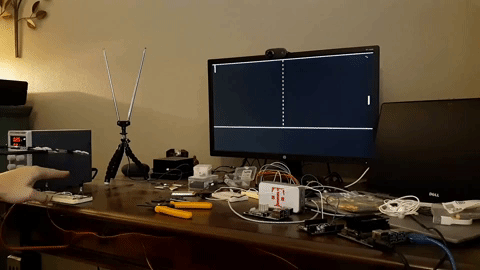Raspberry Pi Pico Pong Project Uses Wii-Like Motion Controls
How to play motion controlled Pong on a Pico.
What if the Nintendo Wii came out in the 1970s? You’d probably get something similar to Nick Bild’s motion-controlled Pico Pong project, which is pretty much what it says it is on the tin. But instead of coming in a big, fancy, wood-paneled box like the typical Pong console, Bild’s Pico Pong does all of its computing off of one 2 x 0.8 inch Raspberry Pi Pico microcontroller. Just...ignore the giant breadboards it uses for its IR motion controls.

Just because Pico Pong uses a modern Raspberry Pi microcontroller doesn’t mean there isn’t some old-school tech here, though. Better dig out your VGA cables, because Bild actually wrote a VGA generator into his Pico to display the game. Pico Pong outputs a 640 x 380 @ 60 Hz VGA signal, but if that resolution sounds tiny to you, don’t worry. Because of memory constraints, the usable screen size is actually even smaller, at 640 x 350.
But you don’t need a high resolution for pong, nor do you need color, which Bild says he could have included but opted not to because writing the VGA generator was enough hassle already. The real draw here is the IR motion controls, which Bild set up using a clever LED system that’s not too far off from the type of laser-powered motion detector you might see in a Mission Impossible movie.
Essentially, each side of the Pico Pong’s breadboard fires an LED up at a mirror being held up by a pair of QuadHands, which then reflects down into a receiver below. You can then place your hand over the LED to block the light signal, which the breadboard will take as a sign to move your paddle either up or down depending on which LED you’re blocking.

Basically, it’s a complicated button press, but so are 90% of the motion controls on the actual Wii. As for how you’d control more than one paddle, say for some multiplayer, you can’t right now. On top of rigging up a display signal and motion controls, Bild’s also implemented computer control into the paddle opposing the player’s, which means the game is one-player only for now.
Like the best Raspberry Pi projects, you can find the full instructions for building Pico Pong yourself, including a parts list and Bild’s code, over on the project’s GitHub page.
Get Tom's Hardware's best news and in-depth reviews, straight to your inbox.
Michelle Ehrhardt is an editor at Tom's Hardware. She's been following tech since her family got a Gateway running Windows 95, and is now on her third custom-built system. Her work has been published in publications like Paste, The Atlantic, and Kill Screen, just to name a few. She also holds a master's degree in game design from NYU.
